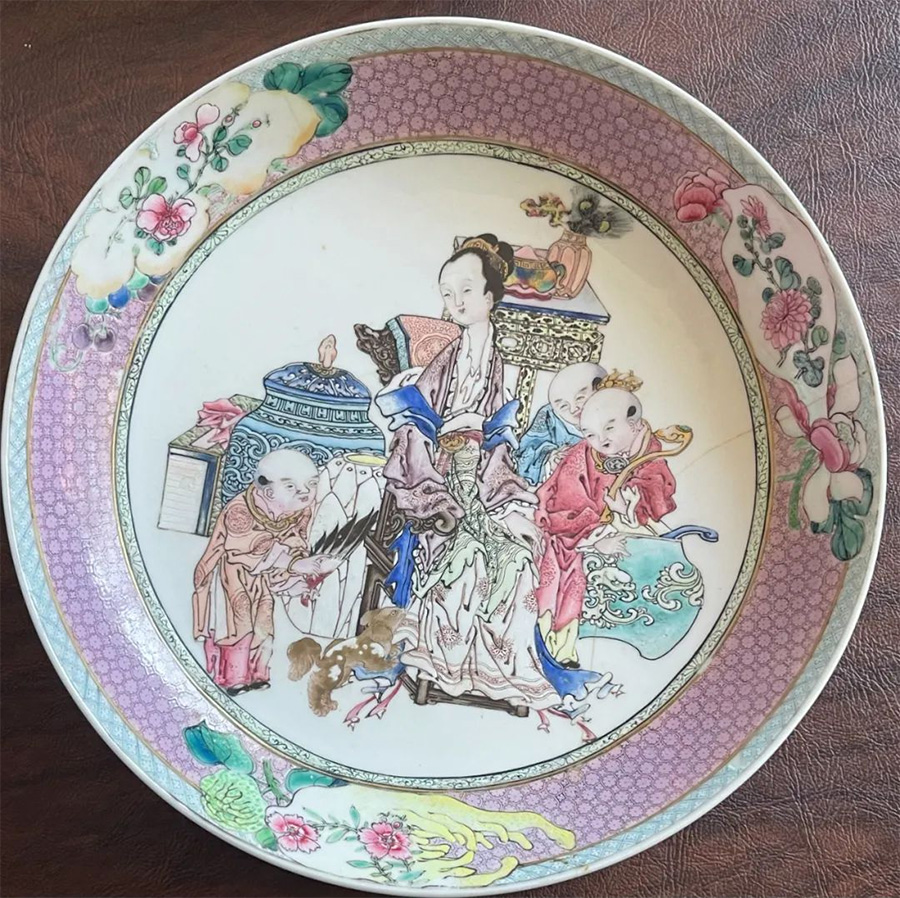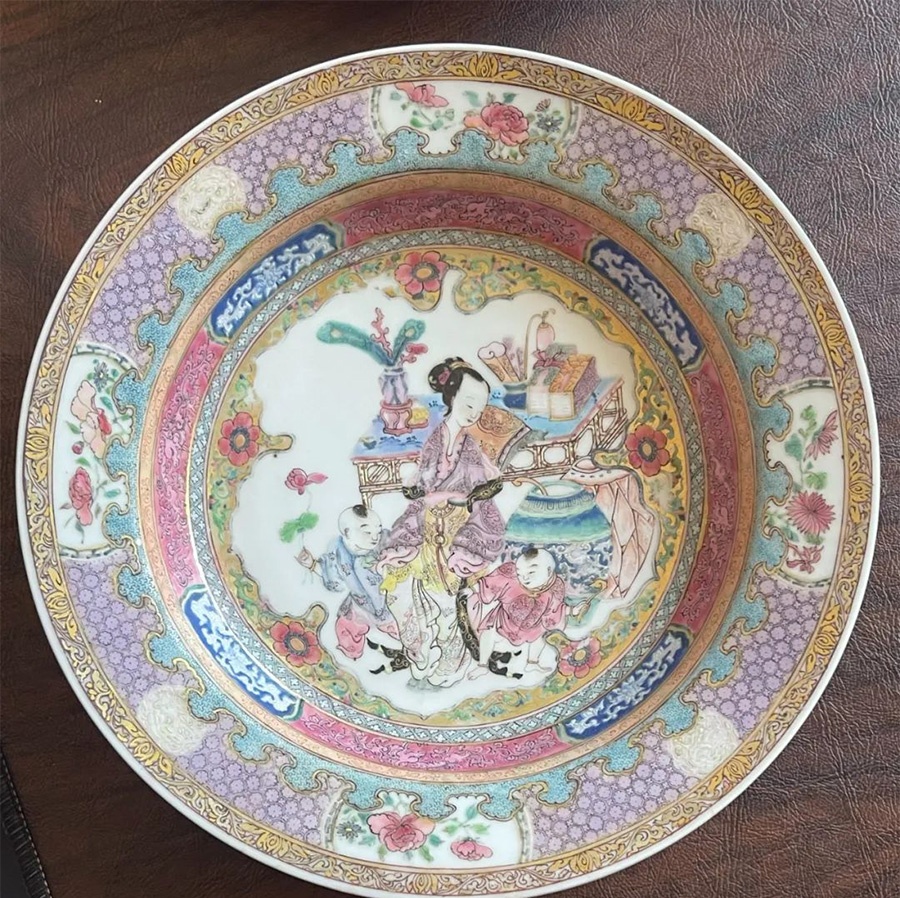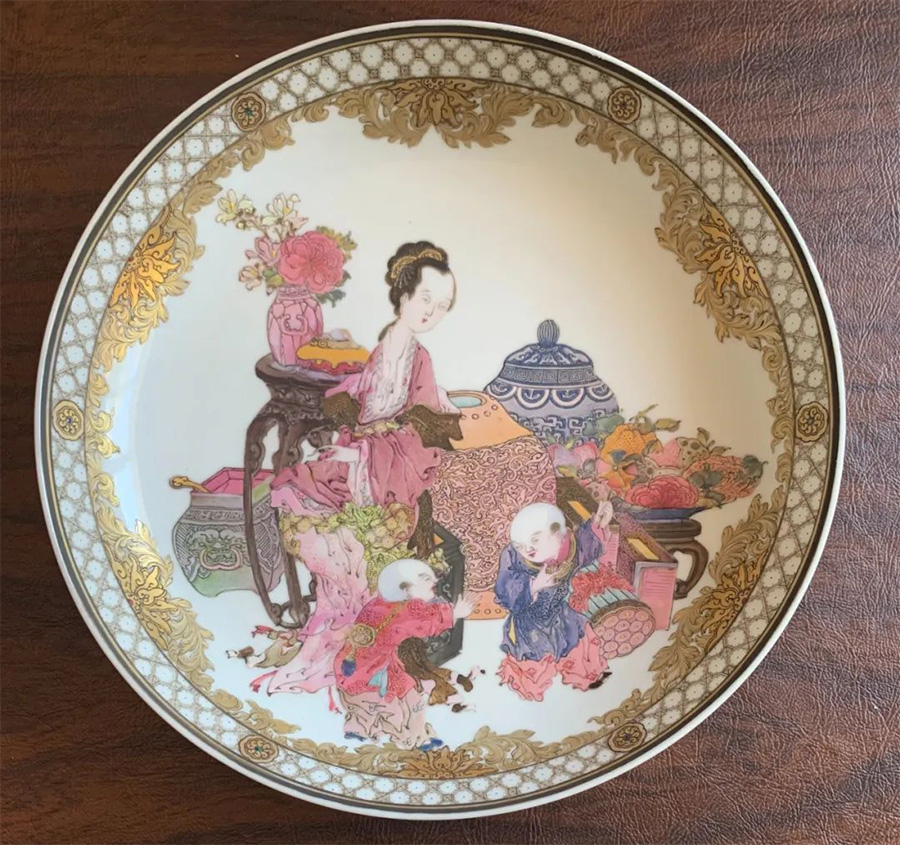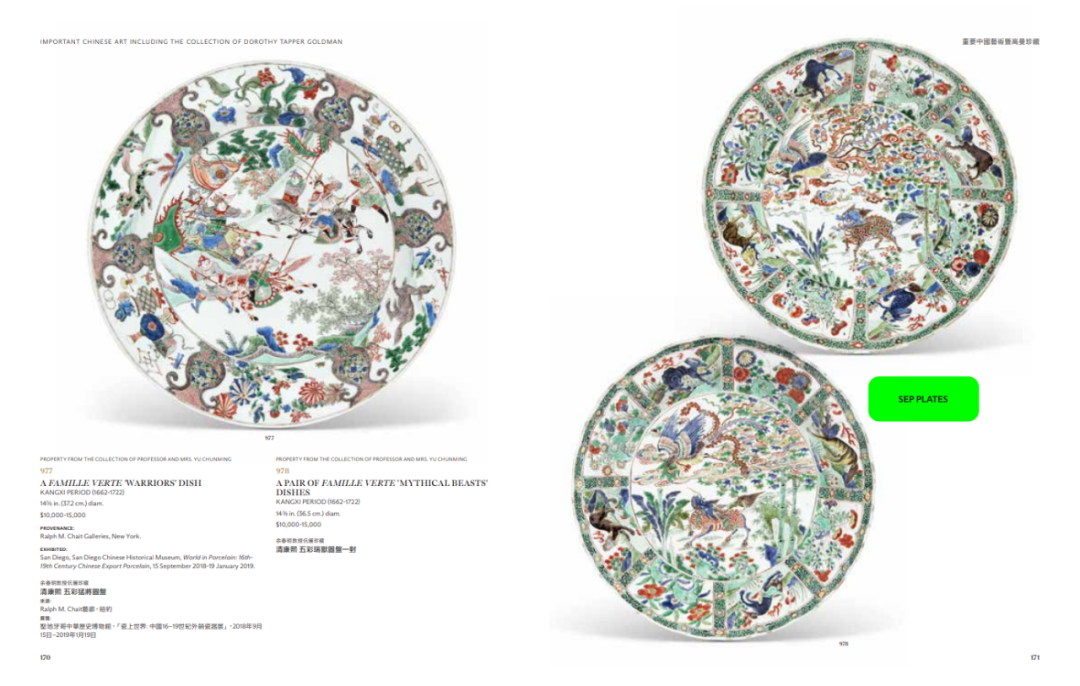清雍正年祚雖短,但瓷業昌盛,詣臻高峰,堪稱中國瓷器史的黃金時代。雍正瓷器釉色齊備,屢創新品,胭脂紅地彩繪即一大成就。胭脂紅釉清麗雅緻,作地巧拼粉彩圖案之玲瓏小盤、小盌,瓷質細薄猶如蛋殼,施釉細膩且繪畫傳神。胭脂紅地與粉彩紋飾佈局多樣,有通體互參,有壁上開光,有襯綴邊飾,一概構圖凝練,時見虛實相間,華而不縟。紋飾主題豐富,以各類人物故事居多,如仕女嬰戲,背景博古儒雅,又不乏各式花鳥圖案,如雉雞或夔鳳牡丹,亦偶見瓜瓞碧桃、山水樓閣等等。

雍正胭脂紅粉彩水平超卓,不論燒造技術,抑或美學成就,都建基於景德鎮四百年的造瓷偉業。作為歷史悠久的陶瓷重鎮,景德鎮窯早年已駕馭燒製胎白質細的高溫釉瓷技術,陶匠對釉下彩、釉上彩的掌控亦相當精練。然而,及至1720年前後,「粉彩」(又稱「洋彩」、「琺琅彩」)技術方臻於成熟,確立「雍正粉彩」的顯赫地位。法國耶穌會士裴德祿(Père d'Entrecolles)1720年代從景德鎮寄出的書信,曾鉅細無遺地記述當地瓷器,所涉之底款及紀年為後世留下寶貴的文字紀錄。現存雍正帶款範例的水平之高,即其藝術成就之一大佐證。可按商貿文件溯源之景德鎮外銷瓷器,也提及過「玫瑰粉色」的新穎品種,例如瓷胎細薄的粉彩茶具,即帶有荷蘭東印度公司按1728年硬幣圖案設計之紋章。
近半世紀,隨著學者對清宮檔案的反複研究,加上釉彩科學分析技術日益進步,上述粉彩簡史逐漸得以補缺拾遺。十七世紀,含砷酸鉛的白釉成爲掐絲琺瑯的釉彩精髓,康熙御製玻璃器也用上嶄新色料。長久以來,有說清帝對色調的審美標準,受耶穌會士來華進貢的歐洲彩繪琺瑯器所影響,遂令御器廠加以研發新釉。據清檔所載,康熙皇帝力求進步,嚴選中外巨匠進駐官窯提升技術,記錄指1716年有廣州官員派遣廣府匠師上京協作。

這種新興「粉彩」的重要成分,包括從膠態金中提煉出來的玫瑰粉色、含錫鉛的不透明白、含錫酸鉛的不透明黃以及含錫鉛的釉上鈷藍。中國的含鉛白有別於歐洲的含錫白(荷
蘭代爾夫特、波斯及土耳其用之模仿中國瓷器)。前者有助彩料提升濃淡層次,增强色度變化,令彩瓷紋飾更趨細膩。受中國古畫啟發,雍正粉彩瓷器不時以花鳥為題,其畫意生動,筆觸酣暢,且偶發新潮,為盤、盌繪飾極其複雜的邊飾圖案。
在粉彩燒造工藝尚未成形之時,瓷匠多用銅紅發色,調製深沉至翠艷等效果。除鈷藍以外,銅紅是當時唯一能承受高溫的顏料,雖極難控制,但若謹慎處理,即能在還原性氣氛過程中形成一種朦朧幽眇的非凡色調一一「郎窯紅」及「海棠紅」(又稱「蘋果紅」、「豇豆紅」或「美人醉」)。康熙郎窯紅聞名遐邇,多以製作典雅秀巧的文房用品。涵蓋太白尊、印盒之「八大碼」深受時人青睞,足証當時氧化銅釉的燒製技術已甚爐火純青。

清初窯務雖已如日方中,雍正釉色則更上一層樓,其時品類百花齊放,胭脂紅可謂一枝獨秀。前述胎薄質細的小巧盤盌,一類外壁罩施胭脂紅釉,内壁精勾細勒,拼凑宛轉美妙的粉彩紋飾,堪稱雍正瓷器的神來之作。有學者推測,瓷坏之輕盈纖細可歸功於前朝的脫胎或半脫胎法,成就雍正細器「薄如卵幕」之美譽。至於色地粉彩,胭脂紅的烘托更見相得益彰,不然紋飾坐落幾近透明的光素背景,略顯索然無味。
雍正胭脂紅地粉彩之魅力無遠弗届,自十九世紀以來一直深受西方鑑藏家青睞,例見現藏大英博物館的大維德爵士(Percival David)珍藏、美國華府國家美術館 P.A.B.·維德納(P.A.B. Widener)珍藏、聖路易斯藝術博物館詹姆士·A·加蘭(James A.
Garland)珍藏及大都會博物館班雅明·阿特曼(Benjamin Altman)珍藏。時至今日,這些曠古佳器風采依然,中外藏家無不對雍正官窯彩瓷趨之若鶩。
馬博懿
獨立學者,著有《青花四千年:費里林海森珍藏中日外銷瓷》
(本文所刊登藏品来自余春明教授的收藏)

RUBY-BACK PORCELAINS: An Extraordinary Achievement of the Yongzheng Kilns
It was during the relatively short reign of the Yongzheng emperor that arguably the finest enameled Chinese porcelains were made, and Yongzheng ‘ruby-back’ wares represent a pinnacle of this production. Meticulously painted in the new ‘famille rose’ palette of delicate tones and subtle shading, ruby-back dishes and small bowls were often formed of the very thin porcelain known as ‘eggshell’, further enhancing their refinement. Some have edge-to-edge decoration, typically asymmetrical and with compelling use of negative space, while many display charming scenes with complex series of intricately patterned borders. Favored subjects for these scenes were elegant mothers and their sons, the women seated on rattan and wood benches amongst large, floor-standing jars and tables of antiques. Others featured cockerels or phoenix alongside lush peonies or, more occasionally, clusters of fruits or even landscape.

The technological and aesthetic achievement of these exquisite porcelains was the culmination of 400 years of porcelain production at Jingdezhen. Jingdezhen kilns had long mastered the many steps necessary to the creation of high-fired, glazed wares with fine, white vitrified bodies as well as the sophisticated painting of both underglaze and overglaze enamels. But it was the further development of the so-called ‘famille rose’ palette (called, in its different iterations, yangcai, fencai or falangcai in China) in about 1720 that enabled the achievements of the Yongzheng era. The arrival of this pivotal new palette has long been broadly understood from both the evidence of mark and period examples and the surprisingly detailed and accurate 1720s letters written from Jingdezhen by the French Jesuit Père d’Entrecolles. Yongzheng marked pieces demonstrate that this enameling had been mastered, as do datable export pieces displaying the new, opaque rose pink, such as the very thinly potted teawares enameled with the arms of the VOC after a coin of 1728.

But in recent decades this story has been fleshed out by both research into Chinese Imperial archives and scientific analysis of enamel components. The lead-arsenate white that is key to the new palette was known to Chinese cloisonné makers in the 17th century. And under the Kangxi emperor the Imperial glassworks were conversant with the new enamels, as seen in a small group of Kangxi yuzhi pieces. It is likely, as long believed, that Jesuit gifts of European painted enamels had whetted the Imperial appetite for the further development of this enhanced palette. Qing Imperial archives reflect the Kangxi emperor’s desire for progress with the new style, and both foreign and local enamelers were recruited, as recorded in 1716 by a Guangzhou official who dispatched enamelers to the workshops in Beijing.

Crucial to the new ‘famille rose’ palette were a rose-pink derived from colloidal gold, a lead-potassia opaque white, an opaque lead-stannate yellow, and a new, lead-potassia cobalt blue used overglaze. The Chinese lead-based white differed from the European tin-based white (used
at Delft, in Persia and in Turkey to simulate Chinese porcelain). It allowed the Chinese enamelers to create subtle shading and multiple tones of enamel color, enabling the creation of extremely delicate and refined decoration on porcelain. Bird and flower subjects inspired by Chinese painting traditions display the enameling mastery of the Yongzheng period potters, whose wares often showed an extremely spare elegance, sometimes with sophisticated innovations like the continuation of a motif over the rim of a dish or bowl.

Before the new ‘famille rose’ palette was mastered Chinese potters had used copper-red enamel to create both deep reds and a ruby pink. The only pigment other than cobalt blue able to withstand a high-temperature firing, copper-red was difficult to control, but with great care could be fired in a reduction atmosphere to create a deep magenta red (langyao) or the deep rose known as ‘peachbloom’ (in Chinese, sometimes known as pingguo hong, apple red, jiangdou hong, bean red, or meiren zui, drunken beauty). The famed Kangxi period peachblooms made for the scholars table, the Eight Great Numbers, or ba da ma, show both the kilns’ mastery of the copper oxide glazes by this period and also the esteem with which these wares were held.
But it was under the Yongzheng emperor that perhaps the greatest use was made of the deep rose or ruby glaze. Combining exquisitely fine decoration in the new enamel palette on the front of a dish or the interior of a bowl with a copper-red – or ruby – solid glaze on its exterior was an innovation of the Yongzheng kilns. Some scholars have speculated that this innovation came about because of the elegantly thin potting of these wares, some ‘eggshell’ and some ‘semi-eggshell’. A ruby glaze on their backs provided a solid canvas for the finely enameled scenes that otherwise would have been rendered on an almost transparent surface.

Ruby-back porcelains of the Yongzheng period have been highly desirable in the West since they were first collected early in the 19th century. The holdings of major museums reflect their prominence in such collections as that of Percival David (the British Museum), P.A.B. Widener (National Gallery, Washington DC), James A. Garland (St. Louis Art Museum) and Benjamin Altman (the Met). Today, these meticulously painted, finely potted porcelains remain as fascinating as they no doubt were at the court of Yongzheng in the 1720s and 30s.
Becky MacGuire
Independent Researcher
Author, Four Centuries of Blue & White: the Frelinghuysen Collection of Chinese & Japanese Export Porcelain








